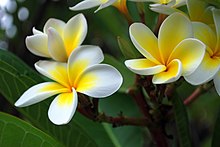Plumeria
| Plumeria | |
|---|---|
 |
|
| Plumeria sp. | |
| Scientific classification | |
| Kingdom: | Plantae |
| (unranked): | Angiosperms |
| (unranked): | Eudicots |
| (unranked): | Asterids |
| Order: | Gentianales |
| Family: | Apocynaceae |
| Subfamily: | Rauvolfioideae |
| Tribe: | Plumerieae |
| Genus: |
Plumeria L. |
| Synonyms | |
|
|
Plumeria (/pluːˈmɛriə/ is a genus of flowering plants in the dogbane family, Apocynaceae. Most species are deciduous shrubs or small trees. The species variously are indigenous to Mexico, Central America, the Caribbean, and as far south as Brazil, but are grown as cosmopolitan ornamentals in warm regions. Common names for plants in the genus vary widely according to region, variety, and whim, but frangipani or variations on that theme are the commonest. Plumeria also is used directly as a common name, especially in horticultural circles.
Plumeria flowers are most fragrant at night in order to lure sphinx moths to pollinate them. The flowers yield no nectar, however, and simply dupe their pollinators. The moths inadvertently pollinate them by transferring pollen from flower to flower in their fruitless search for nectar.
Plumeria species may be propagated easily from cuttings of leafless stem tips in spring. Cuttings are allowed to dry at the base before planting in well-drained soil. Cuttings are particularly susceptible to rot in moist soil.
There are more than 300 named varieties of Plumeria.{American Plumeria society, Florida.
The genus is named in honor of the seventeenth-century French botanist Charles Plumier, who traveled to the New World documenting many plant and animal species. The common name "" comes from a sixteenth-century marquess of the noble family in Italy who invented a plumeria-scented perfume. Many English speakers also simply use the generic name "plumeria".
...
Wikipedia
